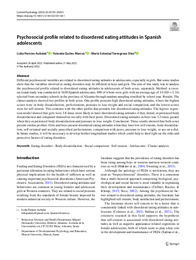Por favor, use este identificador para citar o enlazar este ítem:
https://hdl.handle.net/11000/31303Registro completo de metadatos
| Campo DC | Valor | Lengua/Idioma |
|---|---|---|
| dc.contributor.author | Pamies-Aubalat, Lidia | - |
| dc.contributor.author | QUILES, YOLANDA | - |
| dc.contributor.author | Torregrosa Díez, María Soledad | - |
| dc.contributor.other | Departamentos de la UMH::Ciencias del Comportamiento y salud | es_ES |
| dc.date.accessioned | 2024-02-08T12:17:58Z | - |
| dc.date.available | 2024-02-08T12:17:58Z | - |
| dc.date.created | 2022 | - |
| dc.identifier.citation | Current Psychology Volume 42, pages 20193–20202, (2023) | es_ES |
| dc.identifier.issn | 1936-4733 | - |
| dc.identifier.issn | 1046-1310 | - |
| dc.identifier.uri | https://hdl.handle.net/11000/31303 | - |
| dc.description.abstract | Different psychosocial variables are related to disordered eating attitudes in adolescents, especially in girls. But some studies show that the variables involved in eating disorders may be different in boys and girls. The aim of this study was to analyse the psychosocial profile related to disordered eating attitudes in adolescents of both sexes, separately. Method: a crosssectional study was conducted in 1630 Spanish adolescents, 890 of whom were girls with an average age of 14 (SD = 1.34) selected from secondary schools in the province of Alicante through random sampling stratified by school year. Results: The cluster analysis showed two profiles in both sexes. One profile presents high disordered eating attitudes, where the highest scores were in body dissatisfaction, perfectionism, pressure to lose weight and social comparison, and the lowest scores were for self-esteem. This contrasts with the other profile that presents low disordered eating attitudes. The logistic regression model showed that girls were 3.8 times more likely to have disordered eating attitudes if they dieted, experienced body dissatisfaction and compared themselves socially with their peers. Disordered eating attitudes in boys was 3.3 times greater when they experienced body dissatisfaction and pressure to lose weight. Conclusion: These results showed that both sexes present similar profiles. Girls and boys present disordered eating attitudes when they have low self-esteem, body dissatisfaction, self-oriented and socially prescribed perfectionism, comparison with peers, pressure to lose weight, or are on a diet. In future studies, it will be necessary to develop further longitudinal studies which could help to shed light on the risks and protective factors of eating disorders. | es_ES |
| dc.format | application/pdf | es_ES |
| dc.format.extent | 10 | es_ES |
| dc.language.iso | eng | es_ES |
| dc.publisher | Springer | es_ES |
| dc.rights | info:eu-repo/semantics/openAccess | es_ES |
| dc.rights | Attribution-NonCommercial-NoDerivatives 4.0 Internacional | * |
| dc.rights.uri | http://creativecommons.org/licenses/by-nc-nd/4.0/ | * |
| dc.subject | Eating disorders | es_ES |
| dc.subject | Body dissatisfaction | es_ES |
| dc.subject | Social comparison | es_ES |
| dc.subject | Self-esteem | es_ES |
| dc.subject | Adolescents | es_ES |
| dc.subject | Cluster analysis | es_ES |
| dc.subject.other | CDU::1 - Filosofía y psicología::159.9 - Psicología | es_ES |
| dc.title | Psychosocial profile related to disordered eating attitudes in Spanish adolescents | es_ES |
| dc.type | info:eu-repo/semantics/article | es_ES |
| dc.relation.publisherversion | https://doi.org/10.1007/s12144-022-03164-1 | es_ES |

Ver/Abrir:
Artículo publicado impreso.pdf
609,86 kB
Adobe PDF
Compartir:
 La licencia se describe como: Atribución-NonComercial-NoDerivada 4.0 Internacional.
La licencia se describe como: Atribución-NonComercial-NoDerivada 4.0 Internacional.
.png)